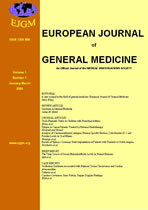
|
European Journal of General Medicine
Medical Investigations Society
ISSN: 1304-3897
Vol. 3, Num. 3, 2006, pp. 146-147
|
European Journal of General Medicine, Vol. 3, No. 3, 2006, pp. 146-147
THE IMPORTANCE OF EARLY DIAGNOSIS AND TREATMENT OF ACUTE RENAL FAILURE DUE TO MICROSCOPIC POLYANGIlTIS
Abdullah Uyanık, Hatice Odabaş
Atatürk University, Medical School, Department of Internal Medicine, Erzurum,Turkey.
Correspondence: Hatice Odabas Atatürk Üniversitesi Postanesi, Posta Kutusu: 26 25171 Erzurum, Turkiye Tel: 05334638318 E-mail: odabashatice@yahoo.com
Code Number: gm06031
Microscopic polyangiitis is a non-granulomatous necrotizing vasculitis involving small vessels. Clinical manifestations are highly polymorphic, but rapidly progressive glomerulonephritis is one of the most frequent and most severe manifestations of the disease. Most patients with MPA present with or develop severe renal disease, particularly if the diagnosis is delayed. We report the case of P-ANCA-positive Microscopic polyangiitis with acute renal failure which had improved with intensive immunosupresive therapy.
Key words: Microscopic polyangiitis, acute renal failure
INTRODUCTION
Microscopic polyangiitis (MPA) is a systemic small-vessel vasculitis primarily associated with necrotizing glomerulonephritis and pulmonary capillaritis. These patients have predominant involvement of glomerular capillaries but without granuloma formation, such as is seen in Wegener’s granulomatosis (1,2).
Unlike classical polyarteritis nodosa most patients with MPA present with or develop severe renal disease, particularly if the diagnosis is delayed (3). In this report we describe a patient with acute renal failure and lung involvement due to microscopic polyangiitis but which had improved clinical and radiological findings with intensive immunosupresive therapy.
CASE
A 55 -year-old woman was admitted to our hospital complaining of oliguria, fever, dyspnea, myalgia and arthralgia. The patient had been well until five months earlier, when he began fever athralgia and myalgia. Two months before admission when he noted weight loss (8 kg in 5 months), fatigue, dyspnea, cough and blody sputum. Before the current admission to our department he suddenly developed oliguria and azotemia and therefore was transferred to our department. There was no history hypertension, renal disease, tuberculosis and skin rash. The patient’s family history was unremarkable. On physical examination, she was adynamic and pale, the systemic blood pressure was 150/90 mmHg, the temperature was 38.4 C, no rash or lymphadenopathy was seen.
The urinary analysis revealed macroscopic hematuria. One week after admission, the patient’s renal function started to deteriorate with a rising serum creatinine. The daily urine output was about 400 ml per day. Chest radiography showed diffuse reticulonodular pulmonary shadowing. Laboratory tests showed: ESR 110 mm/h (Westergren), CRP 4.2 mg/dl (normal value < 0.8 mg/dl), haemeglobin 9 g/dl, platelet 450000/ mm3, blood urea nitrogen 75 mg/dl, creatinine 6.6 mg/dl. Serum electrolytes were normal. Albumin 3.7 gr/dl, cholesterol 198 mg/dl, triglycerides 118 mg/dl. The 24-h urinary protein excretion was 6 g. Antinuclear and anti-DNA antibodies were negative. P-ANCA 120U/ml (positivity >10U/ml) was found as very high. An ultrasound of the kidneys showed normal findings.
The patient denied renal biyopsy. Vasculitis was considered because of high sedimentation rate, normal kidney dimensions in ultrasonography, dysmorphic erythrocytes in urinary sediment, 6 g proteinuria and high rate p-ANCA. Our case was distinguished from Wegener’s granulomatosis throughout the elavation of p-ANCA. Therefore the patient was accepted as MPA. Methylprednisolone (1000 mg/day for 3 days) and cyclophosphamide (500 mg for one day) pulse therapy were administered. The serum creatinine level decreased to 1.2 mg/dl in 20 days and the patient was discharged on methylprednisolone 1mg/kg/day and cyclophosphamide 1000 mg per month.
DISCUSSION
MPA is a systemic vasculitis that is histologically characterized by small vessel involvement (2).
The renal manifestations can present as a rapidly progressive glomerulonephritis or that of a more indolent, remitting, and relapsing course that leads to substantial glomerulosclerosis (3). The clinical presentation of renal disease is with microscopic haematuria, frank haematuria, and proteinuria. Over 90 percent of patients have renal impairment, and in most series no fewer than 30 percent of patients were oliguric by the time the diagnosis was made (2).
Symptoms of lung disease are found in about 50% of patients and usually take the form of haemoptysis, pleurisy and pulmonary haemorrhage (1-4). The patient was treated with steroid and cyclophophamide pulses, followed by oral methylprednisolone and monthly cyclophosphamide which resulted in a significant response, as three weeks later the parameters indicating vasculitic activity were negative (sedimentation 20 mm/h, p- ANCA normal, protein 450 mg/day, urinary sediment was normal). Interestingly, the patient’s renal failure progressed in a few days and the renal function improved after pulses therapy.
The treatment of ANCA associated small vessel vasculitis and glomerulonephritis consists primarily of the use of induction high-dose corticosteroids and cyclophosphamide (2-5). Patients with pulmonary hemorrhage also benefit from plasmapheresis. With the use of an alkylating agent, the rate of remission is around 75%, but relapses occur in about 30% of patients who achieve a remission, and in about 17% of patients after renal transplantation (3). Despite the improved outcome of patients with ANCA vasculitis in the recent decade, their long-term prognosis continues to be primarily determined by a rapid diagnosis, and the prompt institution of therapy.
REFERENCES
- Becker-Merok A, Nossent JC, Ritland N Fibrosing alveolitis predating microscopic polyangiitis. Scand J Rheumatol 1999;28:254-6
- Adu D, Bacon PA. Classical polyarteritis nodosa, microscopic polyarteritis, and Churg-Starus syndrome. In: Maddison PJ, Isenberg DA, Woo P, Glass DN eds. Oxford Textbook of Rheumatology. Oxford University press1998;1351-65
- Falk RJ, Nachman PH, Hogan SL, Jennette JC. ANCA glomerulonephritis and vasculitis: a Chapel Hill perspective. Semin Nephrol 2000;20:233-43
- Franssen CF, Stegeman CA, Kallenberg CG, Gans RO, De Jong PE, Hoorntje SJ, Tervaert JW Antiproteinase 3- and antimyeloperoxidase-associated vasculitis. Kidney Int 2000; 57:2195-206
- Bosch X. Microscopic polyangiitis (microscopic polyarteritis) with late emergence of generalised Wegener’s granulomatosis. Ann Rheum Dis 1999;58:644-47
Copyright 2006 - Medical Investigations Society
|
